Learn about Jacopo Tintoretto in Art History, view his art and famous paintings
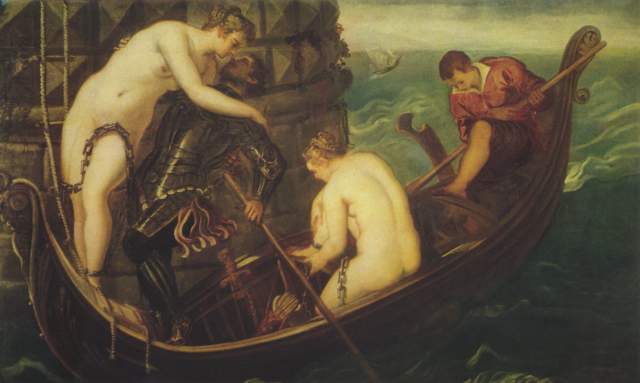
"The Rescue of the Arsinoe", Jacopo Tintoretto, 1560
Jacopo Tintoretto, 1519-1594, one of Italy’s famous artists in art history painted approximately fifty artistic paintings for Scuola di San Rocco and its neighboring church in Venice The best of Tintoretto’s famous paintings, is the "Crucifixion", painted in 1565.
The scene is a panoramic view of Golgotha. Action is everywhere. Jesus Christ is on the cross, the figure below is about to give him a drink of vinegar. The thief on the left is tied to his cross and in the process of being elevated. The other thief is now being tied to his cross still lying on the ground.
Even though Jacopo Tintoretto’s artwork is somewhat confusing with all the activity, the soldiers, the workmen, men on horses, and mourners, the entire painting is divided heavily and compositionally along an intersecting "x" behind the standing figure looking up a Jesus Christ at the foot of the cross.
The ladder on the lower left frontal plane is confusing to perfect three-dimensional space although it does aid the eye entering the artwork. Because the point of the “x” division is high compositionally setting view; (there is greater space in the upper triangle of the "x" than the lower triangle of the "x"), the ladder looks as if it is standing on end toward the viewer. Clearly it is rendered flat on the ground, probably an inconsistency typical of the Mannerist Style.
Titian's art influences the strong diagonal figure groupings in this composition. Jacopo Tintoretto was known to set up mock stage configurations using wax figures putting grid patterns floor to study light and foreshortening. Using these stage settings, it was easier to "blow up" the final composition onto a larger surface area ready for painting.
It is difficult to trace the artists Tintoretto studied under. It is known he was student of Titian for a short time then banished from the studio having produced a drawing Titian didn’t like. While Titian was a master craftsman using many glazes to heighten or deaden areas of color achieving compositional harmony, Tintoretto was chose a different direction. He painted quickly and loosely, once accused of painting with a broom.
Jacopo Tinteoretto primed his canvases with flat dark tones, gray-green, brown, or slate gray. He sometimes sectioned the canvas and then primed these areas according to the tonal quality he planned to achieve when the painting was finished. The figures were then, sketched, outlined and then painted on top of the dark priming that now served as the basic tone for shadows. This is why the underlying darks dominate Tintoretto's famous artwork. The over painting thinned allowing the dark priming to show through where needed.
In order to bring the painting to life, bright colors and highlights were added as a final touch. This system is somewhat similar to a person painting with pastels on a blackboard, the blackboard being the dark areas.
One of the more interesting famous paintings by Jacopo Tintoretto in art history is the "Last Supper", painted in 1592.
 The strong diagonal is here again leading the eye into the depth of the painting. The artistic light source for the painting is the glory of Jesus Christ and the burning oil lamp chandelier. Beneath the table diagonal is the more corporeal world we all live in while above the diagonal table is the spiritual world of angels, illuminated by the glorious light of Christ, as well as the light and smoke of the burning oil lamp. The silhouetted oil lamp in front of a bright light signals of the coming Baroque Art style. Other famous artists of the Renaissance art style are Mathias Gruenwald and El Greco.
The strong diagonal is here again leading the eye into the depth of the painting. The artistic light source for the painting is the glory of Jesus Christ and the burning oil lamp chandelier. Beneath the table diagonal is the more corporeal world we all live in while above the diagonal table is the spiritual world of angels, illuminated by the glorious light of Christ, as well as the light and smoke of the burning oil lamp. The silhouetted oil lamp in front of a bright light signals of the coming Baroque Art style. Other famous artists of the Renaissance art style are Mathias Gruenwald and El Greco.
To view Jacopo Tintoretto in a Mannerist painting gallery, click here.
Click on the graphics below to increase graphic sizes. At the same you time can also view an opportunity to purchase a poster or painting reproduction.
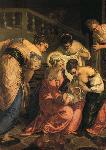


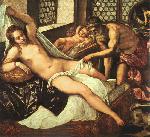
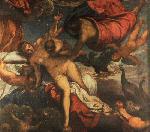
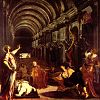










|
